The History Of Nissan Cedric

The Nissan Cedric (Japanese: 日産・セドリック) is a large automobile produced by Nissan since 1960. It was developed to provide upscale transportation, competing with the Prince Skyline and Gloria which were later merged into the Nissan family. In later years, the Nissan Skyline was positioned as a sports sedan/ coupe, whereas the Nissan Gloria was turned into a sporty version of the Cedric (with identical styling but using a different radiator grille and front & rear light clusters). In Japan, the Cedric/ Gloria series was affectionately called Cedglo, and this long running series finally came to an end in October 2004, replaced by the Nissan Fuga. The Cedric name is still in use though, on the Y31 fleet vehicle, updated in 2005 and still in production. Throughout the many versions of the Cedric, it was always considered to be the prime competitor to the Toyota Crown. The hood ornament was inspired by the diamond pattern used by Lincoln but was changed to two right angles set next to each other.
According to Japanese Wikipedia, the Cedric name was inspired by the main character, Cedric, in Francis Hodgson Burnett's novel "Little Lord Fauntleroy" by the Nissan CEO at the time Katsuzi Kawamata.
The first Cedric was the "30" series, introduced in April 1960 and produced through 1961. It used a 1.5L (1488cc) G-series I4 engine which produced 71hp (53kW). The 1.9L (1883cc) H-series with 95hp (71kW), a 2.8 L K series Straight 6 producing 115PS and a 2.0 L SD20 Straight 4 diesel were optional. A 4-speed manual transmission with the top three gears synchronized was standard, and a 3 speed automatic transmission, sourced from Borg Warner was offered in July 1964. The first Cedric featured two stacked headlights on either side of a large grille. The Cedric replaced the Austin A50 Nissan was building under license. The Cedric was introduced with a wrap-around front windshield. The Cedric also introduced Nissan's first monocoque body. April 1962 saw the introduction of a station wagon/ van, able to seat 8 people.
The "31" series was produced for 1962 and 1965. The quad headlights were now mounted horizontally, but the same engines were used. The Cedric was updated in 1964 with a new dashboard, an alternator rather than a generator, and a new starter system. A new grille was adopted for 1965.
The Cedric Special, produced from 1965 to 1971, was a long wheelbase version with extra chrome and other luxury additions. The Cedric Special became the Nissan President, being Nissan's only full size sedan with a V8 engine. The N71 3 speed automatic transmission was introduced in this vehicle. The front suspension used double wishbone and coil springs architecture, with semi-elliptical leaf springs and a live axle for the rear suspension.
The first Nissan Y40 V8 engine was also introduced in this vehicle.
Produced from 1965 through 1971, the P130 Cedric had fashionable Pininfarina bodywork and several new engine options.
On August 1966, Nissan Motor Company and Prince Motor Company merged.
Trim Levels offered were the 130 DX, the P130, the DX-GL, the Personal DX-V, the Custom and the Special.
Engines:
- 1965-1971 2.0L (1983cc) H20 OHV I4, 99hp (74kW)
- 1965-1971 2.0L (1973cc) J20 OHV I6, 109hp (81kW) (Standard and Deluxe)
- 1965-1971 2.0L (1991cc) SD20 OHV Diesel I4, 60hp (45kW) (Diesel)
- 1965-1971 2.0L (1998cc) L20 OHC I6, 112hp (84kW)
- 1965-1971 2.0L (1998cc) L20 OHC twin-carb I6, 123hp (92kW) (Special 6)
- 1968 2.3L (2263cc) L23 OHC I6, 123hp (92kW)
- 1969-1971 2.4L (2393cc) L24 OHC I6, 130hp (97kW)
The 230 series appeared in 1971 and was produced through 1975. The Cedric name was dropped for most export markets, with the car now called the Nissan 200C, 220C, 240C, 260C. The Nissan Gloria was introduced after the Prince Motor Company had been merged with Nissan. The 230 series was offered in 4 door sedan and wagon, and saw the introduction of a 2 door coupe. The coupe was introduced as a result of the Toyota Crown coupe.
Front disc brakes were added to the standard equipment list.
On August 1972, a 4 door hardtop sedan, with no "B" pillar between the front and rear passenger side windows was added to the options list. The 4 door hardtop had a standard interior dome light and a secondary fluorescent lamp that extended from the front to rear passenger seats, attached to the ceiling for ambient purposes. The Cedric was now being built at the Tochigi factory location. The suspension configuration remained the same type used in the second generation. The 3.0 L engine was replaced with the 2.6 L to conform to emission regulations enacted in April 1973.
The trim levels offered were the 2600GX, the Custom 2600DX, the DX, and the DX hardtop.
Engines:
- 2.0L (1982cc) H20 OHV I4
- 2.0L (1991cc) SD20 OHV Diesel I4
- 2.0L (1998cc) L20A OHC I6
- 2.2L (2164cc) SD22 OHV Diesel I4
- 2.4L (2393cc) L24 OHC I6
- 2.6L (2565cc) L26 OHC I6
The 330 series was produced from 1976 through 1979. Again, it was sold as the Gloria as well as the 200C, 220C, 260C, and 280C (after 1978).
The diesel engine returned, called the Diesel DX, and was able to run on LPG for taxi use. Emission controls were further adjusted in 1976.
Trim levels offered were the Deluxe, Custom Deluxe, GL, GL-E, SGL, SGL-E, 2800SGL, and 2800SGL-E. The SG Brougham also first appeared. The "SG" designation stands for Senior Grade, and the "E" represents fuel injection.
October 1977 saw 1 million Cedrics produced.
Halogen headlights were added in June 1976.
Engines:
- 2.0L (1982cc) H20 OHV I4
- 2.0L (1991cc) SD20 OHV Diesel I4
- 2.0L (1998cc) L20A OHC I6
- 2.2L (2164cc) SD22 OHV Diesel I4
- 2.4L (2393cc) L24 OHC I6
- 2.6L (2565cc) L26 OHC I6
- 2.8L (2753cc) L28 OHC I6
As with the 230, the 330 also came in the following body shells. Sedan, Wagon and Van, Coupe and rare pillarless Hardtop Sedan.
The 430 series was produced from 1979 through 1983. Engines carried over from the previous generation, but Nissan offered just one engine for export,; the 2.8L L28 OHC I6, and thus had just one name in export markets, the 280C. The engine gained fuel injection in 1982. The diesel engine that was reintroduced with the previous generation was upgraded to a Straight 6 and 2.8 L, a first for the Japanese market. Styling was achieved with the cooperation of Pininfarina, providing a clean image from the previous generation. The rear suspension was upgraded to a rigid link coil system. A lock-up torque converter was added to the 4 speed automatic transmission. A convertible option was made available for special events. The trim level of SGL-F was available with a turbocharged engine in April 1981.
The 2.0 L turbocharged L20ET first appeared in December 1979, a first for the Japanese market.
For taxi fleet in Singapore and Hong Kong, the 2.2 liter diesel engine was still used in the 220C. This model has four round headlights.
4-wheel disc brakes became standard with this generation.
The 2 door coupe was no longer offered, and was replaced by the first generation Nissan Leopard luxury sports coupe.
Main article: Nissan 300CThe Y30 was sold from 1984 through 1987. It used the 3.0L (2960cc) VG30E V6 for the 300C private cars. The diesel engine was used for taxi in Japan, Singapore, and Hong Kong.
The front suspension was upgraded from double wishbone to MacPherson strut, with optional sonic modified suspension.
This generation saw the introduction of the VG series V6, which was inspired by an Alfa Romeo design.
The sedan was meant to target the German luxury executive cars that dominated the class in the 80s (Mercedes S-Class, BMW 7-series). Trimmed in moquette cloth, the car featured adjustable front seats, adjustable steering wheel, power steering, air conditioning, tinted windows, a LW/ MW/ FM stereo/ cassette player, and the V30 3.0L V6. The sedan featured the same independent front suspension as the wagon, but had a five-link suspension system for ride quality. A five-speed manual gearbox and the V6 engine gave the sedan a max speed of 120 mph (190 km/ h), with 0-60 mph being achied in about 8.4 seconds.
Trim levels added the Brougham VIP to the top of the list, including Turbo Brougham VIP and the Turbo Brougham, released June 1984.
A high mounted center brake lamp was added March 1994, as well as CFC free air conditioning.
This was the last year of the wagon/ van.
Main article: Nissan Cedric Y31For private use, the Y31 was built from late 1987 through 1991, available as either Sedan or Hardtop versions. The sporty GranTurismo SV version has short bumpers with body kit, and powered by 2.0 liter VG20DET engine. The Sedan version of the Y31 was rebodied at the launch of the Y32, and is still in production up to this day for Japanese rental fleet and taxi markets. The vehicles air conditioning could be adjusted by a infrared remote controlled hand held unit from the rear seat, located in a separate compartment attached on top of the rear armrest at the front. Separate air conditioning and heating vents were provided for rear seat passengers.
Trim levels are Original, Custom, Super Custom, Classic, Classic SV, and Brougham VIP. There was also a long wheelbase model built by Autech.
The wagon and van were no longer offered.
Engines:
- 2.0L VG20E
- 2.0L VG20DET
- 3.0L VG30E
- 3.0L VG30ET turbocharged
- 2.5L TD25 diesel
- 2.7L TD27 diesel
- 2.0L RB20P 6 cylinder LPG
- 2.0L NA20P 4 cylinder LPG
- 2.8L RD28 diesel
This version of the Cedric was bodystyle update of the Y31 model. The Cedric had a market reputation appealing to an older demographic, with the sister car Nissan Gloria, with a more performance oriented reputation finding younger buyers. This model shared much of its mechanicals with the newly released Cedric Cima which was a sales success for the Cedric line. The Y32 was produced from late 1991 through 1994. It has had SOHC and DOHC versions of the VG series V6, alongside with Diesel 2.8 version. A 4 cylinder engine was no longer available for the lower trim levels. The performance oriented Gran Turismo reverted back to four round headlights, giving the vehicle a similar appearance to the BMW 7 series sedan sold at the time. Manual transmission were no longer available. Power window switches were illuminated for easy location at night. The parking brake was no longer operated by center mounted hand operated handle, and were relocated to a pedal next to the brake pedal. Interior lighting operates gradually when any door is opened, a shortwave radio tuner is included with the stereo system, and maintenance reminders are also added.
Engines:
- 2.8L RD28
- 2.0L VG20E
- 3.0L VG30E
- 3.0L VG30DE
- 3.0L VG30DET
The Y33 was sold from late 1994 through 1998. The VG series engine was replaced with the newly developed VQ series and the displacement of the Straight 6 diesel was reduced from 2.8 to 2.5. AWD ATESA E-TS, found on the Skyline, Laurel and Stagea, was added to the options list. One of the major advantages of the VQ series over the VG series was the aluminum alloy block and heads, helping to reduce weight. This generation of the Cedric is built in LHD for export to Middle East markets.
Engines:
- 2.0L VQ20DE
- 2.5L RB25DET
- 2.5L VQ25DE
- 3.0L VQ30DE
- 3.0L VQ30DET
The Y34 entered production in 1998 and lasted through 2004.
The line-up consisted of the 250L and LV (naturally aspirated 2.5 litre V-6), 300LV (naturally aspirated 3 litre V-6) and 300LX/ 300VIP (3 litre turbo V-6), all with rear wheel drive; additionally there was the 250L/ LV Four featuring all-wheel-drive and a turbocharged version of Nissan's 2.5 litre inline six diesel. Direct injection is added to all engines for improved performance and reduced emissions, signified by the "DD" designation in the engine model number. AWD is only available on vehicles equipped with the RB25DET engine. A CVT transmission was available on the 300 VIP-Z and 300 LX-ZS trim levels. Top level Cedrics are comparable to the newly released Nissan Cima, which is similar to the top of the line Nissan President but not as long. Autech releases a special 40th anniversary of the Cedric, with the VQ30DET engine.
Satellite guided navigation is added to this generation.
In October 2004, the last Cedric hardtop was built, replaced by the Nissan Fuga.
Prices (in 1999) ranged from Y 3.110.000 for a base 250 L to Y 4.940.000 for the ultra-luxurious 300VIP.
Export version Y35
Strictly speaking, the Y35 did not supersede the Y34, as this model was only exported to the United States as the Infiniti M45 and used the Y34 chassis. It was not Nissan Cedric, but similar Nissan Gloria with a V8, using Nissan's 340hp VK45DE V8. Otherwise, it was mechanically (and stylistically) similar to the Y34.
From Wikipedia, the free encyclopedia
More About Nissan Cedric


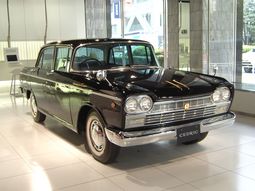
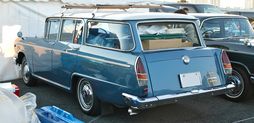

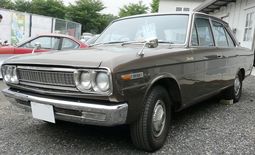

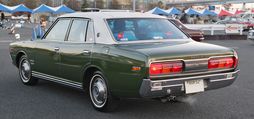
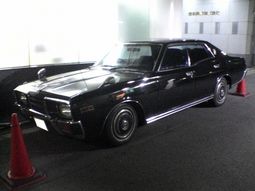
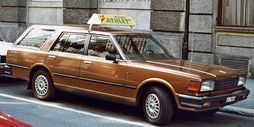



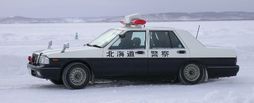

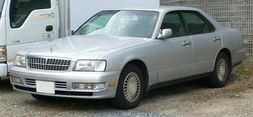
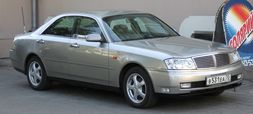
|